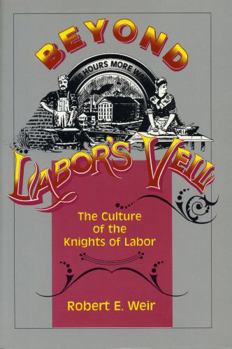Beyond Labor's Veil: The Culture of the Knights of Labor
Select Format
Select Condition 
Book Overview
The Noble and Holy Order of the Knights of Labor was founded in 1869 as a secret fraternal order committed to the goal of uniting American labor. At its height in 1886, the Knights claimed the allegiance of perhaps a million workers. Despite a host of local studies by the new labor historians of the 1970s and 1980s, there has been no general study of the Knights since Norman Ware's 1929 book, and no one has ever attempted a comprehensive study of the culture of the organization. In Beyond Labor's Veil, Robert E. Weir presents a fascinating cultural portrait of the Knights across regions, covering the years 1869 to 1893. From the start, the Knights of Labor was an unusual organization, equal parts fraternal order and labor union. It was the only nineteenth-century labor organization to organize African Americans, women, and unskilled workers on an equal basis with white craftsmen. Weir goes beyond the rhetoric of public pronouncements and union politics to consider the real influence of the Knights--in communities and homes as well as in the workplace. Weir explores the many cultural expressions of the Knights--ritual, religion, poetry, music, literature, material objects, graphics, and leisure. Although the Knights barely survived into the twentieth century, Weir concludes that the creative cultural expressions of the Knights enabled it to do as well it did in the face of powerful oppositional forces. What emerges in Beyond Labor's Veil is a rich, detailed description of the Knights as its members adapted to the confusion and contradiction of America's Gilded Age. Robert E. Weir is Associate Professor of Liberal Arts at Bay Path College in Longmeadow, Massachusetts.
Format:Paperback
Language:English
ISBN:0271029269
ISBN13:9780271029269
Release Date:April 1996
Publisher:Penn State University Press
Length:364 Pages
Weight:1.17 lbs.
Dimensions:0.8" x 6.0" x 9.0"
Customer Reviews
1 rating
Creation of Labor Culture
Published by Thriftbooks.com User , 24 years ago
In following the precepts of revisionist history, Robert Weier avoids the traditional analysis of institutional history of the Knights of Labor. In its place emphasizes in understanding the men, women, and ethnic groups that composed this organization and focuses on the culture it envogued during the Gilded Age era. In which strongly attracted large amounts of workers to the Knights of Labor platform; however, those tools did not reinforce the universal values desired among its membership. The KOL proceeded through five stages during its existence. It began as a fraternal, secretive brotherhood organization to insure the livelihood as an entity. The next ushered in the evolution from a secretive to a public established organization. The third phase, which is the main focus of the book, is the experimentation, modification, and creation of a worker culture defined by the Knights of Labor. Then KOL experiences a period of decline and decentralization allows more flexibility of local KOL taverns initiatives. The dwindling of membership and the leadership witnessing the union die, attempted in a last ditch effort to unify and re-solidify itself it reverted back to its fraternal beginnings. The culture that manifested itself under the KOL leadership encouraged a more cooperative relationship between labor and capital. The songs had motifs of Jesus condemnation of Mammon worship, KOL as the true beholders of true Christianity and patriots. The literature was less direct in nature regarding a clear potential conflict between labor and capital.





